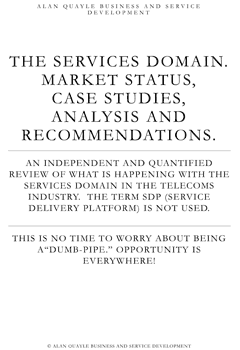An independent and quantified review of what is happening with the services domain in the Telecoms Industry. The term SDP (Service Delivery Platform) is not used. This is no time to worry about being a “dumb-pipe” opportunity is everywhere!

Published: Feb 2012
Pages: 267
Figures: 132
Operators Interviewed: 73
Detailed Operator Case Studies: 17
Single User: $1499
Company License: Contact me
You are buying an electronic document. Upon payment, an email
will be sent with a link and password to download this report.
View more details: Table of Contents, Foreword, What others are saying
Summary
An operator is composed of three domains: Network, IT and Services. Historically we’ve treated the services domain as something that can be solved by a piece of technology, called the SDP (Service Delivery Platform). This has resulted in the industry’s slow response to the competitive threats of web-based service providers, which are now starting to bite. The services domain encompasses people, processes and technology: the technology is IT centric; the processes use methods like Scrum / XP (eXtreme Programming) and embrace risk; and the people are focused on the customer not the shareholders or technology or the network.
This report brings together the successes we’re seeing in the market through a series of case studies, an independent survey of the market to capture the reality of where we are and what we are planning, with a set of independent recommendations on how we can move forward and better nurture service innovation rather than kill it.
In putting this report together a market survey was conducted across operators and suppliers from November 2011 through to January 2012. 117 responses were received: 73 from operators and 44 from network equipment providers, system integrators, software solution providers, and other technology suppliers. The survey gathered as globally a representative sample as possible across operator types, markets, supplier categories, and the respondent’s role within their organization.
We are entering a period of unprecedented revenue uncertainty in regulated services, as discussed in thie previous article. The market survey gathered a range of views on the revenues within the telecoms industry through to 2019. In the optimistic case the industry revenue growth varies between 1-1.75%, with mobile and fixed data driving the bulk of the growth, and mobile voice remaining flat and fixed voice continuing its decline. Giving a total regulated revenue of $1.6T in 2019. In the pessimistic case the decline varies between flat in 2014 to a nearly a 2% decline in 2019 with a total revenue of $1.4T. Unregulated services are now critical to the future growth of the industry and the services domain is critical to enabling competitive unregulated services.
Governance is a fundamental issue that continues to retard the implementation and success of the services domain. The IT and network domains, which are starkly different to the services domain because they cannot fail which permeates everything they do, dominate budget spend and revenues within an operator. They consider the services domain to be a tax on their organizations. And similarly the OpCos (Operating Companies within an Operator Group) dominate what they do in-country, and consider group-wide services domain projects to equally be a tax on their hard earned revenues. It is all about people and processes within operators, not technology.
The small services domain projects by spend and revenue impact are simply too small for the CEO to be concerned about, and the time frame of their impact is beyond 3 months, hence out of the CEO’s focus which is the next investor call. Yet that is what is required to enable the change necessary to a services and customer focused organization. Arguments of, “it’s strategic”, have been tried before with the SDP and failed. Something different is required as we’re entering a new phase of our industry, revenue growth is now uncertain.
There is no obvious answer to the governance issue; else it would already be solved. The Telefonica case study has shown how exception people can make the services domain happen, but the Telefonica story is far from over, as discussed in the case study the battles between Telefonica Digital and the IT Domain over the UNICA SDP are not yet apparent. The Mobily, Etisalat and STC case studies highlight the importance of CEO involvement, but now the spotlight is off them the challenges may come back. We need a systematic way of solving the innovators dilemma, and that can only come from the top. The future success of the operator needs to matter more than it currently does given the inflexion point. Other Case studies reviewed include: Oi Brazil, SoftBank, Telkomsel, Etisalat Sri Lanka, Vodafone, Telenor, Telecom Italia, Aircel, Verizon, Megafon, Telefonica, China Mobile, America Movil, and Tata DoCoMo.
